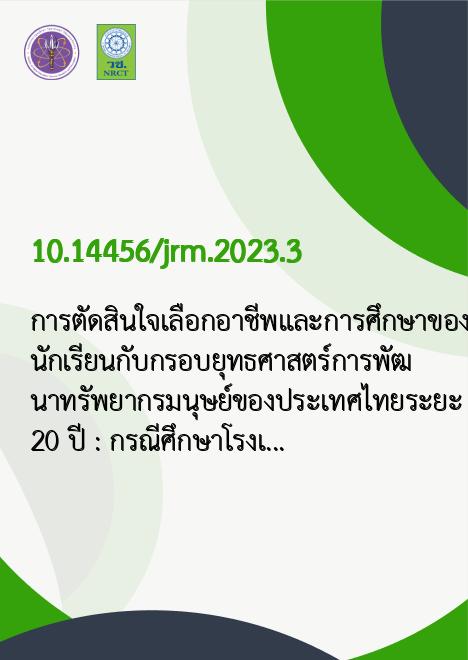
|
การตัดสินใจเลือกอาชีพและการศึกษาของนักเรียนกับกรอบยุทธศาสตร์การพัฒนาทรัพยากรมนุษย์ของประเทศไทยระยะ 20 ปี : กรณีศึกษาโรงเรียนคงทองวิทยา จ.นครปฐม |
|---|---|
| รหัสดีโอไอ | |
| Creator | อรษา ตันติยะวงศ์ษา |
| Title | การตัดสินใจเลือกอาชีพและการศึกษาของนักเรียนกับกรอบยุทธศาสตร์การพัฒนาทรัพยากรมนุษย์ของประเทศไทยระยะ 20 ปี : กรณีศึกษาโรงเรียนคงทองวิทยา จ.นครปฐม |
| Contributor | กมลนัทธ์ มีถาวร, ปัทมา คิดรอบ |
| Publisher | ภาควิชาวิจัยและจิตวิทยาการศึกษา คณะครุศาสตร์ จุฬาลงกรณ์มหาวิทยาลัย |
| Publication Year | 2566 |
| Journal Title | วารสารวิธีวิทยาการวิจัย (Journal of Research Methodology: JRM) |
| Journal Vol. | 36 |
| Journal No. | 1 |
| Page no. | 31-46 |
| Keyword | กรอบยุทธศาสตร์การพัฒนาทรัพยากรมนุษย์ของประเทศไทยระยะ 20 ปี, ทักษะด้าน STEM, เจตคติ |
| URL Website | https://portal.edu.chula.ac.th/pub/jrm/index.php/jrm/index |
| Website title | วารสารวิธีวิทยาการวิจัย (Journal of Research Methodology: JRM) |
| ISSN | ISSN 0857-2933; ISSN (Online) 2697-4835 |
| Abstract | การวิจัยครั้งนี้มีวัตถุประสงค์เพื่อ (1) วิเคราะห์ความสอดคล้องระหว่างการเลือกอาชีพและการศึกษาของนักเรียนชั้นมัธยมกับกรอบยุทธศาสตร์การพัฒนาทรัพยากรมนุษย์ของประเทศระยะ 20 ปี (พ.ศ. 2560-2579) (2) วัดเจตคติของนักเรียนชั้นมัธยมต่อทักษะด้าน STEM และ (3) วิเคราะห์ปัจจัยที่มีผลต่อการเลือกอาชีพและการศึกษาต่อของนักเรียนชั้นมัธยม โดยใช้กรณีศึกษาจากนักเรียนชั้นมัธยมศึกษาปีที่ 1 โรงเรียนคงทองวิทยา จังหวัดนครปฐม เก็บรวบรวมข้อมูลปฐมภูมิจากการสัมภาษณ์นักเรียนจำนวน 300 คน สถิติที่ใช้ในการวิเคราะห์ข้อมูลได้แก่ ค่าความถี่ ร้อยละ ค่าเฉลี่ย ค่ามัธยฐาน ค่าควอไทล์ (Quartiles) ค่าพิสัยระหว่างควอไทล์ (Interquartile range) และแบบจำลองโพรบิท (Probit Model) ผลการวิจัยพบว่า (1) ผู้ตอบแบบสัมภาษณ์ร้อยละ 58.67 อยากเรียนสาขาวิชาที่ใช้ทักษะ STEM อย่างเข้มข้นได้แก่ คณิตศาสตร์ วิทยาศาสตร์ และคอมพิวเตอร์ แต่มีเพียงร้อยละ 36.67 อยากประกอบอาชีพในอนาคตที่ใช้ทักษะ STEM อย่างเข้มข้น ได้แก่ แพทย์ ทันตแพทย์ เภสัชกร พยาบาล สัตวแพทย์ วิศวกร เป็นต้น (2) นักเรียนมีเจตคติที่ดีต่อทักษะด้าน STEM (คะแนนเจตคติเฉลี่ย 7.205 จากคะแนนเต็ม 11 คะแนน) สะท้อนให้เห็นว่านักเรียนเห็นประโยชน์ของทักษะด้าน STEM ดังนั้นรัฐบาลสามารถส่งเสริมและให้ความรู้ด้าน STEM เพิ่มขึ้น เพื่อให้นักเรียนกล้าตัดสินใจเลือกเรียนในสาขาที่ใช้ทักษะด้าน STEM อย่างเข้มข้นเพื่อให้สอดคล้องกับยุทธศาสตร์การพัฒนาทรัพยากรมนุษย์ของประเทศ (3) สาขาวิชาที่นักเรียนต้องการเรียนต่อมีความสัมพันธ์กับอาชีพที่อยากทำในอนาคตอย่างมีนัยสำคัญทางสถิติที่ระดับความเชื่อมั่นร้อยละ 95 (4) ปัจจัยที่มีผลต่อการเลือกสาขาวิชาที่ต้องการเรียนต่อพบว่า เพศ เจตคติต่อทักษะด้าน STEM และอาชีพที่อยากทำในอนาคตมีความสัมพันธ์กับสาขาวิชาที่ต้องการเรียนต่ออย่างมีนัยสำคัญทางสถิติที่ระดับความเชื่อมั่นร้อยละ 95 ในขณะที่อาชีพของผู้ปกครอง และอาชีพของ idol ไม่มีความสัมพันธ์กับสาขาที่ต้องการเรียนต่อและอาชีพที่อยากทำในอนาคตThe objectives of this research were: (1) to analyze the correspondence between career choice and education of high school students and the country's 20-year human resource development strategy framework (2017-2036) (2) to measure attitudes. of high school students on STEM skills and (3) to analyze factors affecting career choices and further education of high school students. Using a case study from secondary 1 students at Kongthong Wittaya school, Nakhon Pathom province. Primary data were collected from interviews with 300 students. The statistics used in the data analysis were frequency, percentage, mean, median, quartile, interquartile range and probit model. The results showed that (1) 58.67% of the respondents wanted to study subjects that use STEM-intensive skills such as mathematics, science, and computers. However, only 36.67 percent wanted to pursue a career in the future that used intensive STEM skills, such as physicians, dentists, pharmacists, nurses, veterinarians, engineers, etc. ;(2) The students had a positive attitude towards STEM skills. It reflects that student see the benefits of STEM skills. Therefore, the government can promote and educate more STEM so that students can choose to study in STEM-intensive fields in line with the country's human resource development strategy ;(3) The field of study that students wish to study further was statistically significantly related to their future occupation at 95% confidence level.;(4) Gender, attitudes towards STEM skills, and future career aspirations were statistically correlated with field that the student want to study at 95 percent confidence level. Parent's occupation and idol’s occupation had no relationship with the field that the student wants to study and the career that the student wants to do in the future. |